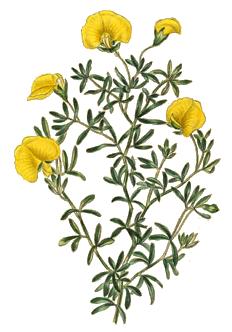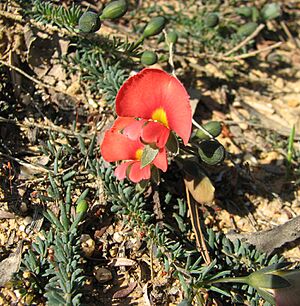Glory peas facts for kids
Quick facts for kids Glory peas |
|
|---|---|
 |
|
| Gompholobium virgatum | |
| Scientific classification | |
| Kingdom: | |
| (unranked): | |
| (unranked): | |
| (unranked): | |
| Order: | |
| Family: | |
| Subfamily: | |
| (unranked): | |
| Genus: |
Gompholobium
Sm.
|
| Type species | |
| Gompholobium grandiflorum Sm.
|
|
| Species | |
|
See text. |
|
| Synonyms | |
|
|
Gompholobium, also known as glory peas or wedge-peas, is a group of plants in the pea family, Fabaceae. These plants are special because they are only found in Australia. Most Gompholobium species have leaves made of three small parts called leaflets. All of them have ten separate stamens (the parts that make pollen) and a unique way their sepals (leaf-like parts that protect the flower bud) are arranged.
Contents
What Do Glory Peas Look Like?
Most Gompholobium plants have leaves made of three separate leaflets. However, some kinds have simple leaves, and others have leaves with many leaflets arranged like a feather. These leaflets grow one after another along the stems and usually have smooth edges.
Flowers and Fruit
The flowers of these plants often grow in groups at the ends of branches. Sometimes, they appear alone or in pairs. The sepals form a short tube with five longer parts. The large petal at the back of the flower is round or kidney-shaped and bigger than the other petals.
Each flower has ten separate stamens. The part that will become the fruit is smooth. The fruit itself is a pod, like a pea pod, and can be oblong or almost round. It holds two or more seeds.
Naming and History
The name Gompholobium was first officially used in 1798 by James Edward Smith. He wrote about it in a scientific paper. In 2008, Gompholobium grandiflorum was chosen as the main example species for the group.
What Does the Name Mean?
The name Gompholobium comes from two Ancient Greek words:
- gomphos, which means "bolt," "peg," or "nail."
- lobos, which means a "capsule" or "pod."
This name refers to the puffed-up shape of the seed pods, which look a bit like a bolt or peg.
Where Do Glory Peas Grow?
Glory peas are found all over Australia. They grow in many different areas across the country.
Types of Glory Peas
There are many different types, or species, of Gompholobium plants. Some well-known ones include:
- Gompholobium ecostatum (Dwarf wedge-pea)
- Gompholobium grandiflorum
- Gompholobium huegelii (Common wedge-pea)
- Gompholobium latifolium (Giant wedge-pea)
- Gompholobium pinnatum
- Gompholobium virgatum
Ecology and Safety
Early settlers in Australia, who brought sheep and goats, noticed that these animals sometimes got sick after eating certain plants. In 1842, a botanist named James Drummond reported that some Gompholobium plants could be harmful to livestock like sheep and goats. This was an important discovery for farmers at the Swan River Colony.


